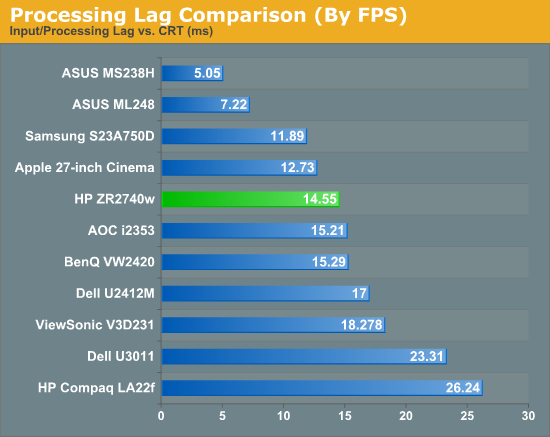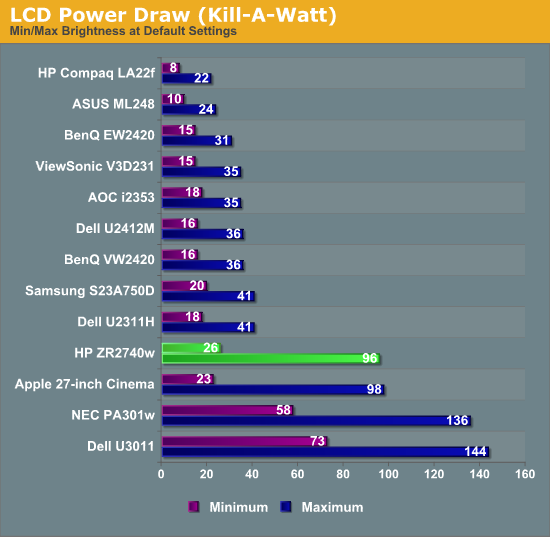HP ZR2740w - High Resolution IPS that Doesn't Break the Bank
by Chris Heinonen on March 16, 2012 1:15 AM ESTInput Lag and Power Use
Since the HP automatically scales the image if it is not sent at 2560x1440 and I don’t have a CRT that can produce that resolution, the HP had to run at 1920x1080 resolution for the lag tests. This is our second review using the SMTT program to test lag, but this lets us separate the input lag from the pixel response time, so we can hopefully figure out the effect of scaling the image. There is a chance that the performance with a native 2560x1440 signal could be better on the input lag, so these measurements again represent the worst case scenario.

Despite this, the lag on the HP is very low overall, with 14.55ms being the worst case scenario. This breaks down at 2.6ms of input lag, and then 11.95ms of pixel response time. This is less than a frame of lag at the 60Hz refresh rate the display supports, so it should be fast enough for your gaming use, though hopefully your video card can keep up with it at 2560x1440. The effective lag, which is a more subjective measurement, came in at right around 10ms in my estimation. At that point you can clearly see what color a pixel was changing to, even if it hasn’t reached peak brightness yet. I really don’t think anyone will have issues gaming on the HP, which is very nice.
With the size of the ZR2740w, and the amount of light that if can put out, you can imagine that even with an LED lighting system it is going to use a lot of power. At minimum brightness the HP consumed 26 watts, and at maximum brightness it consumed 96 watts. With my usual settings (closer to 150-160 nits of brightness) I was seeing closer to 45 watts of power use on it. This isn’t the most efficient display you can get, but when you consider that it is likely to replace dual 24” monitors for a lot of users, the power use is better in perspective. Compared to the 30” monitors we have reviewed it is very good, and about equal to the 27” Apple Cinema Display.











119 Comments
View All Comments
Death666Angel - Friday, March 16, 2012 - link
And another thing: "High gamut displays running sRGB content can sometimes look oversaturated if your applications aren't color space aware." Most WCG monitors offer sRGB modes. My old HP w2408h does, the Dell U2711 does, most NEC and Eizos do....JarredWalton - Friday, March 16, 2012 - link
But with no OSD or scaler, obviously there's no color mode select.Death666Angel - Friday, March 16, 2012 - link
Yes, but the statement in the review makes it sound as if that is a problem with all WCG monitors. Of course it doesn't apply to this model, because it doesn't even have WCG to begin with. But saying this is a plus because WCG monitors are oversaturated when most offer perfectly fine sRGB modes in their standard-OSD sounds to me like someone is looking for ways to promote this mediocre monitor. :-)JarredWalton - Friday, March 16, 2012 - link
I reviewed quite a few wide color gamut monitors back in the day that lacked an sRGB mode. Laptops with wide color gamut often have this issue as well (Dell Studio XPS 16 RGB LED for example). But before you try to imply that we are saying all WCG have problems, let's just look at the article text:"For many users, [77% gamut is] actually not a problem and could even be seen as a plus. (High gamut displays running sRGB content can sometimes look oversaturated if your applications aren't color space aware.)"
*Could* be seen as a plus, *sometimes* look oversaturated. In other words, it depends on the specific monitor and settings available, as well as the intended use.
Oxford Guy - Saturday, March 17, 2012 - link
A better way to state it is:Like most displays on the market, it only has a standard gamut white LED backlight, so it is listed as being able to display 99.9% of the sRGB color space and 77.2% of the Adobe RGB space. The sRGB space is the smallest gamut standard for display purposes, although it is the dominant space for general computing at this time. The Adobe RGB space is larger, but few games offer Adobe RGB content and it is generally limited to specific professional and prosumer usage, such as high-quality printing, photography, and art. General-purpose monitors that offer coverage beyond sRGB should have an effective sRGB emulation mode to avoid oversaturated colors when viewing sRGB content, such as most of the web. Some monitors, such as the Dell U2410, offer accurate sRGB emulation modes.
bryanlarsen - Friday, March 16, 2012 - link
Awesome, these monitors pivot, which is rare for monitors this large. Two of them set up in portrait mode would make an awesome crazy dual screen setup!kasakka - Friday, March 16, 2012 - link
Since you'll be relying on color profiles for accurate colors, I'm guessing by the time you open any app that doesn't support them (mainly games) you will have tinted colors. I don't know how bad it is with factory settigns, but my Dell 3008WFP is pretty awful if you don't use a custom calibration setting set with the OSD.hechacker1 - Friday, March 16, 2012 - link
It depends on the game, but most games that use fullscreen will reset your LUT and mess up the color calibration.It's unfortunate, since the games don't have to do that, but they all seem to do it.
However, there are software work-arounds. My spyder 3 comes with a utility that loads the icc profile every minute just for that reason.
Or you can use DisplaycalGUI to load the profile on demand. Most games will only clear the LUT when they launch, so you can just reload the profile after.
PPalmgren - Friday, March 16, 2012 - link
You know, a lot of people are still skeptical of input lag and I can say for certain that it is a factor having bought an S-PVA panel around 2006/7. While you show all the theoretical factors to these skeptics, I have an idea for a somewhat objective real-world performance test that you could show people, and also manage to have a little fun in the meantime.Ever play those clicky games where you have to click things rapidly? Play them 10 times, alternating, on a very high input lag monitor then on a low input lag monitor. Avarage the scores, and you might be surprised. I'd actually be willing to do this and am curious now that I thought of it. My desk has a 24' TN panel for games and a 24' S-PVA panel beside it. The lag on the PVA panel was the determining factor for me buying my TN panel. As someone with a past as a competitive gamer, I wonder if my scores will show any validity?
Southernsharky - Friday, March 16, 2012 - link
300 is about as much as I will pay for a monitor.